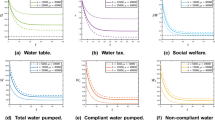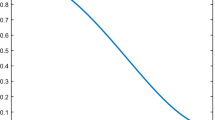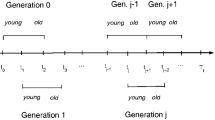Abstract
It is estimated that half of all the water extracted, both in developed and developing countries, is unauthorized. This phenomenon makes the management of a groundwater even more difficult to avoid over-exploitation. To study the interaction between farmers, that could be compliant and non-compliant, and a water agency, we built a leader-follower differential game. However, we assumed that the water agency does not know neither ex-ante nor ex-post the number of compliant farmers. After illustrating the results of the dynamic game through numerical simulation using the Western La Mancha (Spain) data, we endogenize the types’ choice in an evolutionary context. Finally, we perform comparative dynamics in the steady state to understand the role of the sanction to counter illegal behaviors.




Similar content being viewed by others
Notes
Conference on “Water and Agriculture” Events at Mercure Hotel, Boulevard de Lauzelle 61, Louvain-La-Nueve (Belgium), September 2010.
A real world example of a such sanction is given the European Union Emission Trading System, where \(\sigma =\,\)€100 for each tonne of CO\(_2\) emitted for which no allowance has been surrendered, in addition to buying and surrendering the equivalent amount of allowances (see https://icapcarbonaction.com/en/?option=com_etsmap &task=export &format=pdf &layout=list &systems%5B%5D=43).
References
Antoci A, Borghesi S, Sodini M (2017) Water resource use and competition in an evolutionary model. Water Resour Manag 31(8):2523–2543
Biancardi M, Iannucci G, Villani G (2022a) An evolutionary game on compliant and non-compliant firms in groundwater exploitation. Ann Oper Res 318(2):831–847
Biancardi M, Iannucci G, Villani G (2022b) Groundwater exploitation and illegal behaviors in a differential game. Dyn Games Appl 12(3):996–1009
Biancardi M, Iannucci G, Villani G (2023) Inter-temporal decisions, optimal taxation and non-compliant behaviors in groundwater management. Commun Nonlinear Sci Numer Simul 116:106872
Biancardi M, Maddalena L (2018) Competition and cooperation in the exploitation of the groundwater resource. Dec Econ Finance 41(2):219–237
Biancardi M, Maddalena L, Villani G (2020) Groundwater extraction among overlapping generations: a differential game approach. Dec Econ Finance 43(2):539–556
Biancardi M, Maddalena L, Villani G (2020) Water taxes and fines imposed on legal and illegal firms exploiting groudwater. Discrete Contin Dyn Syst B 22(11):1–20
Bomze IM, van Damme EE (1992) A dynamical characterization of evolutionarily stable states. Ann Oper Res 37(1):229–244
Brill TC, Burness HS (1994) Planning versus competitive rates of groundwater pumping. Water Resource Res 30(6):1873–1880
Budds J (2009) Contested H2O: science, policy and politics in water resources management in Chile. Geoforum 40(3):418–430
Castellano I (2020) Water Scarcity in the American West. Palgrave MacMillan, Cham
de Frutos Cachorro J, Erdlenbruch K, Tidball M (2014) Optimal adaptation strategies to face shocks on groundwater resources. J Econ Dyn Control 40:134–153
De Stefano L, Lopez-Gunn E (2012) Unauthorized groundwater use: institutional, social and ethical considerations. Water Policy 14(S1):147–160
Dworak T, Schmidt G, De Stefano L, Palacios E, Berglund E (2010) Background paper to the conference: application of EU water-related policies at farm level
Erdlenbruch K, Tidball M, Zaccour G (2014) Quantity-quality management of a groundwater resource by a water agency. Environ Sci Policy 44:201–214
Esteban E, Albiac J (2011) Groundwater and ecosystems damages: questioning the Gisser-Sánchez effect. Ecol Econ 70(11):2062–2069
Esteban E, Dinar A (2013) Cooperative management of groundwater resources in the presence of environmental externalities. Environ Resource Econ 54(3):443–469
Feinerman E, Knapp K (1983) Benefits from groundwater management:magnitude, sensitivity, and distribution. Am J Agric Econ 65(2):703–710
Gisser M, Sanchez DA (1980) Competition versus optimal control in groundwater pumping. Water Resour Res 16(4):638–642
Hofbauer J (1999) The spatially dominant equilibrium of a game. Ann Oper Res 89:233–251
Kim C, Moore MR, Hanchar JJ, Nieswiadomy M (1989) A dynamic model of adaptation to resource depletion: theory and an application to groundwater mining. J Environ Econ Manag 17(1):66–82
Martínez-Santos P, Llamas MR, Martínez-Alfaro PE (2008) Vulnerability assessment of groundwater resources: a modelling-based approach to the Mancha Occidental aquifer, Spain. Environ Modell Softw 23(9):1145–1162
Negri DH (1989) The common property aquifer as a differential game. Water Resour Res 25(1):9–15
Pereau J-C (2020) Conflicting objectives in groundwater management. Water Resour Econ 31:100122
Pereau J-C, Mouysset L, Doyen L (2018) Groundwater management in a food security context. Environ Resource Econ 71(2):319–336
Pereau J-C, Pryet A (2018) Environmental flows in hydro-economic models. Hydrogeol J 26(7):2205–2212
Pereau J-C, Pryet A, Rambonilaza T (2019) Optimality versus viability in groundwater management with environmental flows. Ecol Econ 161:109–120
Petrohilos-Andrianos Y, Xepapadeas A (2017) Resource harvesting regulation and enforcement: an evolutionary approach. Res Econ 71(2):236–253
Provencher B, Burt O (1993) The externalities associated with the common property exploitation of groundwater. J Environ Econ Manag 24(2):139–158
Rosa L, Chiarelli DD, Rulli MC, Dell’Angelo J, D’Odorico P (2020) Global agricultural economic water scarcity. Sci Adv 6, eaaz6031 (2020)
Roseta-Palma C (2003) Joint quantity/quality management of groundwater. Environ Resource Econ 26(1):89–106
Rubio SJ, Casino B (2001) Competitive versus efficient extraction of a common property resource: the groundwater case. J Econ Dyn Control 25(8):1117–1137
Rubio SJ, Casino B (2003) Strategic behavior and efficiency in the common property extraction of groundwater. Environ Resource Econ 26(1):73–87
Acknowledgements
The research has been funded by the Italian Ministry of Ecological Transition as part of the project“ Water as Sustainable Product–WASP”.
Author information
Authors and Affiliations
Contributions
MB: Conceptualization, Methodology, Formal analysis. GI: Conceptualization, Methodol- ogy, Formal analysis. GV: Conceptualization, Methodology, Formal analysis.
Corresponding author
Ethics declarations
Competing interests
The authors declare no competing interests.
Additional information
Publisher's Note
Springer Nature remains neutral with regard to jurisdictional claims in published maps and institutional affiliations.
Mathematical appendix
Mathematical appendix
1.1 Proof of Proposition 1
The first order conditions with respect to water pumped are:
Solving, we get:
Notice that \({\widetilde{w}}_c>0\) if and only if:
Moreover, \({\widetilde{\tau }}_c>0\) if and only if:
Analogously, \({\widetilde{w}}_{nc}>0\) if and only if:
Notice that \({\widetilde{\tau }}_{nc}>0\) if and only if:
This concludes the proof. \(\square\)
1.2 HJB equation solution
Assuming an interior solution and differentiating the right-side of equation (13) with respect to \(\tau\), we lead:
Replacing \(\tau\) given by (17) in \({\widetilde{w}}_{nc}\) and \({\widetilde{w}}_c\) given by (10) and (11), we obtain:
and
Sustituting (18) and (19) in HJB, and rearranging the terms, it follows:
Being the game a linear-quadratic variety, we postulate a quadratic function of the form:
with the first derivative:
where A, B and C are constant parameters of the unknown value function which are to be determined. Substituting the equations V(H, t) and \(V'(H,t)\) in the HJB, we obtain a system of three Riccati equations for the coefficients of the value function:
Equation (21) admits two real and distinct solutions \(A_1\) and \(A_2\):
where
is always positive. The solution has to satisfy the stability condition \(\frac{d\dot{H}}{dH}<0\). Substituting (18) and (19) in the dynamics of the water table (4), and considering that \(V'(H,t)=2AH(t)+B\), the stability condition becomes:
satisfied for \(A=A_2\). Moreover, from equation (22), we determine the value of \(B=B_2\) as:
Finally,
and
1.3 Proof of Proposition 3
Substituting the values of \(w_c^*\) and \(w_{nc}^*\), given by (24) and (24), respectively, in the water table dynamics (4) we get:
Solving (27) we obtain the optimal trajectory (15). \(\square\)
Rights and permissions
Springer Nature or its licensor (e.g. a society or other partner) holds exclusive rights to this article under a publishing agreement with the author(s) or other rightsholder(s); author self-archiving of the accepted manuscript version of this article is solely governed by the terms of such publishing agreement and applicable law.
About this article
Cite this article
Biancardi, M., Iannucci, G. & Villani, G. Groundwater management and illegality in a differential-evolutionary framework. Comput Manag Sci 20, 16 (2023). https://doi.org/10.1007/s10287-023-00449-z
Received:
Accepted:
Published:
DOI: https://doi.org/10.1007/s10287-023-00449-z




